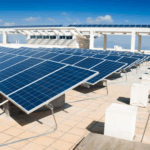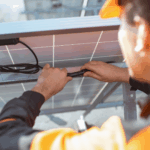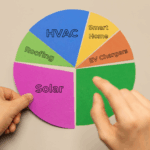
Embarking on the journey of residential solar installation can seem overwhelming, with a myriad of new terms and concepts to understand. To help homeowners navigate this exciting transition to renewable energy, Solar Insure has compiled a comprehensive glossary of common terms related to residential solar installation. This invaluable resource aims to demystify important solar terms, providing clear and concise definitions that make the world of solar energy more accessible and transparent.
Whether you’re just starting to explore solar power or you’re ready to take the plunge into solar ownership, this glossary serves as a convenient reference point to help you understand the nuances of your solar investment.
Balance of System (BoS) – These are all the components of a solar photovoltaic (PV) system, excluding the solar panels. This includes items like mounting structures, wiring, inverters, and monitoring systems.
Battery Storage – An optional component of a solar panel system that allows homeowners to store excess solar energy. The stored energy can then be used during periods of low sunlight or power outages.
Energy Audit – This refers to an assessment of a home’s energy use. The aim of the audit is to identify opportunities for improved energy efficiency.
Feed-in Tariff (FiT) – This is a government program that provides financial incentives for homeowners to generate solar electricity and sell it back to the grid.
Grid Connection – This is the process of connecting the solar photovoltaic (PV) system to the electrical grid. This connection allows homeowners to draw electricity from the grid when needed.
Ground-Mounted Solar – This refers to a solar energy system that is installed on the ground rather than on a rooftop.
Inverter – This is a device that converts the direct current (DC) electricity produced by solar panels into alternating current (AC) electricity. The AC electricity is then suitable for use in the home.
Interconnection Agreement – This is an agreement between a solar energy system owner and the utility company. The agreement outlines the terms and conditions under which the solar energy system is connected to the grid.
Installer – This refers to a contractor or company that is responsible for the installation of the solar energy system.
Kilowatt (kW) – This is a unit of power. It represents the rate at which electricity is generated or consumed.
Kilowatt-hour (kWh) – This is a unit of energy. It represents the total amount of electricity produced or consumed over time.
Microinverter – This is a small inverter installed on each solar panel. It allows each panel to convert sunlight into AC electricity independently.
Module-Level Power Electronics (MLPE) – These are devices, such as microinverters or power optimizers, that are installed at the individual solar panel level. Their purpose is to optimize performance and monitor output.
Monitoring System – This is a system that allows homeowners to track and monitor the performance of their solar photovoltaic (PV) system. This includes monitoring energy production and consumption.
Net Metering – This is a billing arrangement that allows homeowners to receive credits for excess electricity. The electricity is generated by their solar panels and then fed back into the grid.
Off-Grid System – This refers to a standalone solar photovoltaic (PV) system that is not connected to the electrical grid. These systems are typically used in remote areas where grid access is limited.
O&M (Operation and Maintenance) – These are the ongoing tasks necessary to keep a solar energy system functioning optimally. This includes tasks like cleaning, inspections, and repairs.
Performance-Based Incentive (PBI) – This is a financial incentive that provides payments based on the performance of a solar energy system over time.
Performance Ratio (PR) – This is a measure of the actual output of a solar energy system compared to its potential output under ideal conditions.
Permission to Operate (PTO) – It is the final step in the utility interconnection process to receive approval to activate your solar energy system and begin electricity generation.
Photovoltaic (PV) System – This is a system that converts sunlight into electricity using solar panels.
Photovoltaic Cell (PV Cell) – This is the basic unit of a solar panel. It converts sunlight into electricity.
Power Optimizer – This is a device installed on each solar panel. It maximizes power generation by adjusting the panel’s output to current light conditions.
Power Purchase Agreement (PPA) – This is an agreement in which a solar company owns and maintains solar panels on a homeowner’s roof and sells the electricity to the homeowner.
Racking System – This is the structure used to mount solar panels to a roof or the ground.
Roof Orientation – This refers to the direction that the roof faces, which affects the amount of sunlight received by the solar panels.
Single-Line Diagram (SLD) – This is a simplified diagram of an electrical system, including the solar panels, inverter, and connection to the grid.
Site Assessment – This is an evaluation performed by solar professionals to determine the suitability of a location for solar panel installation.
Soiling – This refers to dust, dirt, or other substances that accumulate on the surface of solar panels and reduce their efficiency.
Solar Array – This refers to a group of solar panels wired together to create a single, unified system that generates electricity from sunlight.
Solar Canopy – A structure that provides shade while also housing solar panels.
Solar Carport – A carport equipped with solar panels on the roof, providing shade for parked vehicles and generating electricity.
Solar Efficiency – The percentage of sunlight that is converted into electricity by the solar panels.
Solar Energy – Energy derived from the sun’s radiation.
Solar Financing – Various options, such as loans or leasing, available to homeowners for financing the installation of solar panels.
Solar Incentives – Financial incentives, such as tax credits or rebates, provided by governments or utility companies to encourage the adoption of solar energy.
Solar Insolation – The amount of solar radiation received per unit area over a specific time period.
Solar Lease – A financing arrangement where the homeowner pays a fixed monthly fee to lease the solar energy system from a third-party owner.
Solar Loan – A financing option where the homeowner borrows money to finance the solar energy system, repaying the loan over time.
Solar Panel – A device made up of solar cells that generate electricity when exposed to sunlight.
Solar Permitting – The process of obtaining necessary permits and approvals from local authorities before installing a solar photovoltaic (PV) system.
Solar Renewable Energy Certificate (SREC) – A tradable commodity earned by producing renewable energy, which can be sold to utilities to help them meet their renewable energy goals.
Solar Shading – Obstacles such as trees, buildings, or other structures that block sunlight and reduce the efficiency of solar panels.
String Inverter – An inverter that converts DC electricity from a string (or series) of solar panels into AC electricity.
Sun Path – The arc that the sun follows across the sky, which impacts the amount of sunlight a solar panel receives.
Tilt Angle – The angle at which solar panels are installed on the roof, optimized for capturing maximum sunlight.
Time-of-Use (TOU) Rates – A rate structure where the cost of electricity varies based on the time of day, encouraging homeowners to consume less energy during peak hours.
Warranty – A guarantee provided by the manufacturer or installer that covers defects, performance, and the durability of the solar panels and related components.
Solar Insure’s Glossary of Terms
30-Year Monitoring and Warranty – A product provided by Solar Insure that offers both monitoring and warranty coverage for your solar products and installation.
20-Year Battery Monitoring and Warranty – A product provided by Solar Insure that offers monitoring and warranty for battery coverage. This includes battery replacement if capacity drops below 30% between years 11-20.
Certificate to Product Warranty Registration Form – This is a document you receive 2 to 4 weeks after your system is installed. It marks the beginning of the Solar Insure monitoring and warranty.
Contractor’s liability insurance – This is insurance that covers potential damages to the home during solar installation.
Filing a claim – This is the process of submitting a claim to Solar Insure in the event of component failures or defects.
Homeowner’s insurance policy – This is insurance that typically covers damage to the home and solar panels due to factors such as fire, theft, rodents, and hail.
RMA process – This is the return merchandise authorization process, required in the event of a claim when the manufacturer’s warranty is still in effect.
Roof penetrations – This term refers to the points where the solar installation attaches to the roof.
Solar Insure Partners – Partnerships such as Energy Sage, Solo, and BrightOak are considered our partners. These partnerships aim to extend support to solar installers and homeowners.
Solar Insure Approved Vendor List – This is the list of manufacturers that are covered for Solar Insure’s monitoring and warranty products.
Solar Insure Certified Installers – These are installers approved by Solar Insure to provide their protection plans.
Solar Insure Elite Certified Installers – These are high-performing installers approved by Solar Insure to provide their protection plans.
Solar Manufacturer Default Coverage – This is coverage for when the solar manufacturer defaults. It is backed by an A.M. Best A+ Rated Insurance carrier.
Understanding these terms will help empower homeowners to make informed decisions about going solar. From the search and design process to installation, monitoring, and warranty, each phase involves specific terminology that helps to illuminate the process. With this glossary as your guide, navigating the world of solar energy can become a more manageable and rewarding journey.


